
Few topics spark bigger arguments for couples than things like “how to properly load the dishwasher.” It’s right up there with “getting directions while driving” and “are you sure you’re not sitting on the remote?” And now that there are dishwashers with a window for everyone to see inside, how many of you will be reloading your already stacked racks?
Of course, there’s no one right way. People have their own rules they follow when loading the dishwasher. But whether you follow the “shove-it-all-in-and-hope-it-works-out” method, you’re part of the “load-as-you-go” crowd, or you’ve labeled yourself a “dishwasher-manual-scholar” who has it down to a science—we have a few essential tips for a better loading and cleaning experience. Plus, you can pull these tips out in the future to resolve those recurring spats.

Tip #1: Whatever method you use, don’t overload your dishwasher! This might seem like obvious advice, but it’s the most important tip that’s frequently ignored. You want to make sure all of your dishes have room for the water and cleaning solution to reach them. When dishes are loaded beyond your dishwasher’s capacity, it can sometimes lead to food residue being cooked into your dishes, making it much harder to remove.
Tip #2: With the exception of sharp knives, you should load silverware with the stems on the bottom. Also be sure to space pieces out evenly across the different pockets so they aren’t pressed up against each other too much. This allows the water more time to wash over them and to get the parts that actually touch food nice and clean.
Tip #3: Anything you drink out of, such as cups, mugs, or glasses, should always go on the top rack with the opening facing downward. They’re better protected that way, and this loading position allows more water to clean inside. Of course, always check whether certain glasses are dishwasher-safe.

Tip #4: Bowls should be stacked on a downward incline to ensure that water and cleaning solution can clean the inside. Whether you want to place them on the upper or lower rack is up to you. However, a few of our newest dishwasher models feature TurboZone Reach™ technology, which blasts away bottom-of-the-bowl gunk from dishes placed on the top rack.
Tip #5: Even if they’re dishwasher-safe, it’s best to keep plastics and Tupperware® on the top rack to avoid warping from the hot water.
Tip #6: Plates are best placed on the bottom rack, facing the center, and if they lean at all, lean them inward and downward to avoid chipping and to get the most water exposure. And we hope this is another obvious tip, but do not double stack your plates! Each plate should be in its own row for optimal water and cleaning coverage.
Tip #7: When it comes to pots and pans, never put cast iron or ceramic in the dishwasher. Stainless steel is usually best left to washing by hand. Glass dishes are approved, though! And a few aluminum pots and pans are made to be washed in the dishwasher. As always, check to make sure your cookware is dishwasher-safe.
Where do you fall on the loading method spectrum? Do you have any need-to-know dishwasher loading tips? Tell us in the comments!





